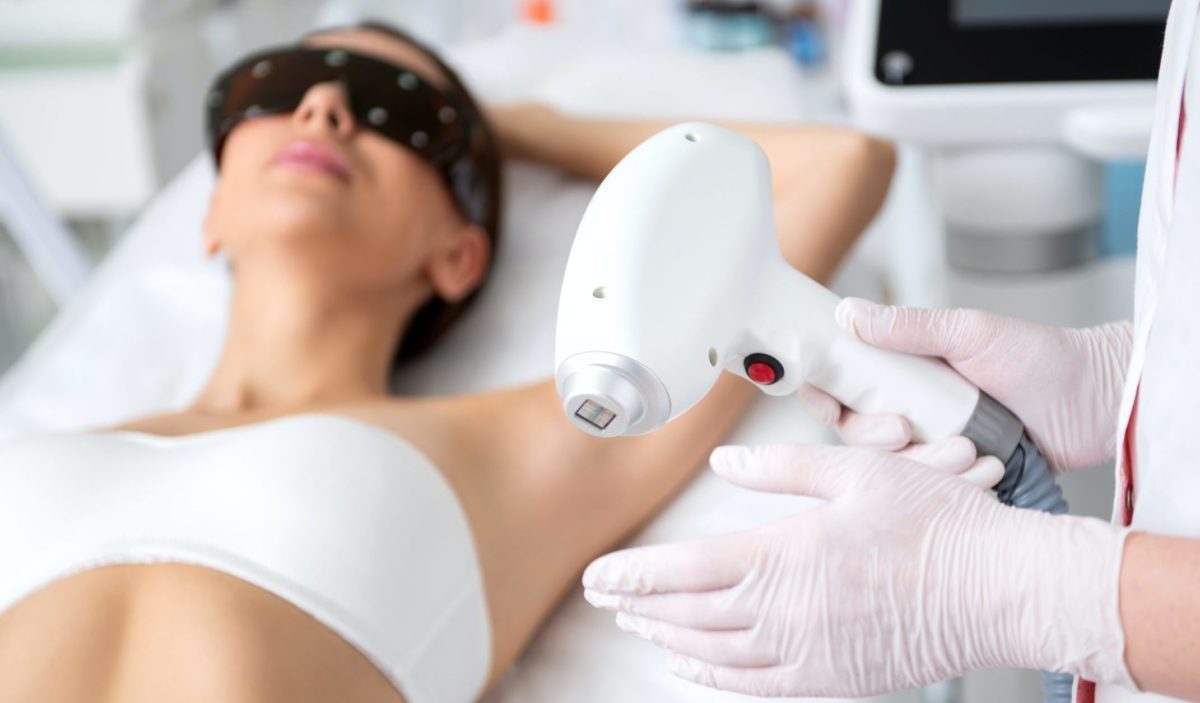COSA È L’EPILAZIONE DEFINITIVA?
Quando si parla di epilazione definitiva si parla di Laser o di Luce Pulsata IPL. Bisogna dire che sono due metodi di epilazione permanente simili con lo stesso obbiettivo, quello di atrofizzare progressivamente la papilla dermica.
COME FUNZIONA L’EPILAZIONE DEFINITIVA CON LA LUCE PULSATA (IPL)?
Secondo il principio della fototermolisi la luce IPL legge la melanina e riscalda così il pelo nel follicolo per una frazione di secondo. Riscaldando il bulbo del pelo durante la fase anagene, la papilla (responsabile della crescita) si distrugge. Di conseguenza in questo follicolo non cresce più un pelo. Il pelo cade nei seguenti giorni dopo il trattamento
COSA COMPRENDE UN TRATTAMENTO?
- Consulenza personalizzata prima del trattamento con le indicazioni e la valutazione delle controindicazioni
- Trattamento COPRO 8-12/14 sedute secondo la zona scelta ogni 21/28 giorni
- Trattamento VISO minimo ogni 10/12 giorni
PRIMA – COME MI DEVO PREPARARE PER IL TRATTAMENTO IPL?
- Niente sole per 14 giorni prima della seduta, vuole dire coprirsi con vestiti, capellino e la protezione 50+ per il viso o le braccia
- Per il trattamento IPL CORPO : Uno o due giorni prima del trattamento utilizzare il rasoio per eliminare TUTTI i pelli
- Per il trattamento IPL VISO: Nessuna preparazione prima del trattamento é richiesta
DOPO – COME MI DEVO COMPORTARE DOPO IL TRATTAMENTO IPL?
Dopo il trattamento si può ritornare alla vita quotidiana normale senza nessun problema.
IMPORTANTE: Niente sole per almeno 14/28 giorni dopo il trattamento IPL perché il sole potrebbe provocare un cambiamento della pigmentazione della pelle. I peli riscaldati cadono entro 21 giorni.
QUALE SONO LE CONTROINDICAZIONI AL TRATTAMENTO IPL?
Le controindicazioni al trattamento includono:
- Febbre acuta
- Influenza acuta di alcol/droghe
- Pelle esposta al sole in modo acuto, uso recente di un solarium
- Scottatura acuta
- Diabete non trattato
- Radiazioni o chemioterapia
- Gravidanza e allattamento
- Debolezza circolatoria, deficienza immunitaria, malattie autoimmuni
Assunzione di farmaci*) come:
- Antiacne come: B. Roaccutane (attesa di 12 mesi)
- Assunzione di glucocorticoidi o di cortisone
- Assunzione di antidepressivi come l’amitriptilina;
- Farmaci antiepilettici come topiramato e carbamazepina;
- Antistaminici come loratadina e ciproeptadina;
- Antimicrobico
- Farmaci come ciprofloxazina, doxiciclina, griseofulvina e minociclina,
- Antipsicotici come clorpromazina e aloperidolo;
- Diuretici come amiloride e spironolattone; sali d’oro,
- Ormoni ematoporfirinici come corticosteroidi, estrogeni, progesteroni e spironolattone;
- Farmaci cardiovascolari come captopril e nifedipina;
- Non steroideo farmaci antinfiammatori come diclofenac, ibuprofene, naprossene e fenilbutazone;
- Inibitori della pompa protonica come omeprazolo e pantoprazolo;
- Sostanze contro la malaria come chinino e clorochina;
- Dermatici sistemici come isotretinoina e metoxsalene
- Citostatici come metotrexato e vinblastina
*) da valutare con il medico personale
PRIMA DI OGNI TRATTAMENTO
È OBBLIGATORIO INFORMARE LA PROPRIA OPERATRICE IN CASO DI ASSUNZIONE DI MEDICINALI NUOVI!
L’EPILAZIONE DEFINITIVA È DEFINITIVA?
Gli studi scientifici parlano di una rimozione dell’80% nell’area trattata per i primi 6 mesi, che arriva a picchi del 85% per il primo anno, per poi tornare a quota 70 – 80% per il secondo anno. Che ci piaccia o no i peli hanno una funzione ben precisa per il nostro corpo quindi in condizioni di buona salute il nostro patrimonio pilifero viene tenuto costante dal sistema ormonale.
Per questo motivo una volta raggiunto un risultato soddisfacente con il trattamento di fotoepilazione è necessario prevedere dei trattamenti di mantenimento che ovviamente saranno molto meno frequenti di quelli effettuati nel periodo iniziale.Oltre ai follicoli piliferi attivi ve ne sono milioni dormienti. Logicamente durante il trattamento di fotoepilazione è possibile agire solo sui follicoli piliferi attivi.
Quindi per mantenere un risultato nel tempo è necessario programmare delle sedute di mantenimento per colpire i follicoli piliferi che si sono attivati successivamente ai trattamenti. I risultati della epilazione definitiva sono sempre molto personali, ma sotto la premessa che il protocollo del trattamento è stato eseguito giusto valgono in generale +/- questi valori del successo:
| RISULTATO | PELO SCURO | PELO CHIARO |
| CON LASER | FINO A 80% | 0 |
| CON IPL | FINO A 80% | FINO A 50% |
CHE FATTORI POSSANO CONDIZIONARE O INFLUENZARE IL RISULTATO?
Come è per tutti i sistemi di epilazione definitiva i fattori genetici e familiari individuali inducono i follicoli, attivandoli, a produrre i peli. In altre parole, ogni essere umano possiede circa lo stesso numero di follicoli piliferi, sparsi sul proprio corpo, ma solo una parte di essi è funzionalmente attiva, altri sono silenti e, pertanto, non producono peli.
I follicoli silenti che non producono peli possono attivarsi sia per motivi fisiologici che in seguito all’induzione di fattori quali l’assunzione di farmaci, (ad esempio cortisone e ciclosporina,) o patologie, soprattutto quelle di origine endocrina che sono responsabili della produzione ormonale.
COSA È LA LUCE PULSATA IPL SHR?
SHR si traduce Super Hair Removal. Quindi una tecnica di epilazione definitiva con grandissimo successo.
In questo sistema sono inglobate l’esperienza della tecnologia laser con i vantaggi del metodo di luce pulsata, combinati e assemblati nella tecnologia SHR. Vengono così raggiunti dei risultati eccezionali senza complicazioni e senza dolori. Anche i capelli biondi, che fina ad ora erano difficili a trattare con la vecchia tecnologia IPL e che ancora oggi sono impossibili da rimuovere con il laser, possono essere finalmente trattati con la nuova tecnologia IPL SHR.
A differenza della epilazione Laser o IPL classico, con la nuova tecnologia SHR, i follicoli piliferi vengono riscaldati gradualmente con un alto tasso di ripetizione d’impulso, ma con un picco di energia inferiore.
Il nuovo sistema “in Motion” riveste un importante passo avanti nella epilazione permanente con luce pulsata. Grazie al sistema di raffreddamento integrato, il trattamento è molto più confortevole rispetto ai sistemi convenzionali, come IPL, laser o l’ago epilazione, la pelle è meglio protetta.

